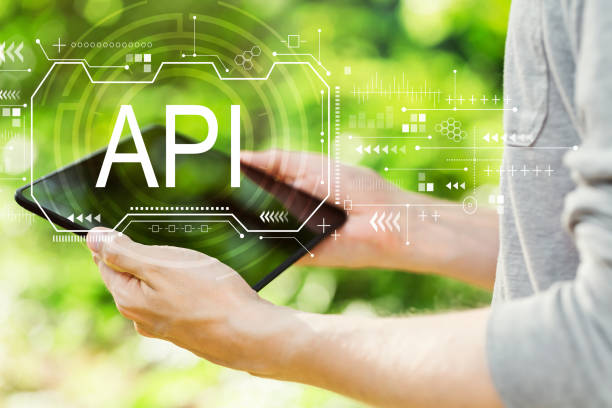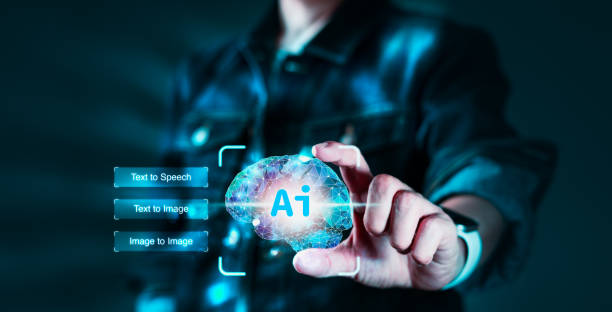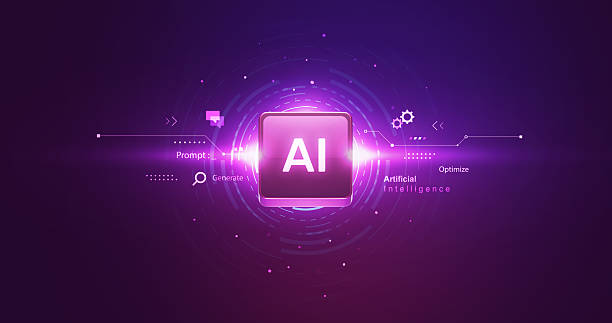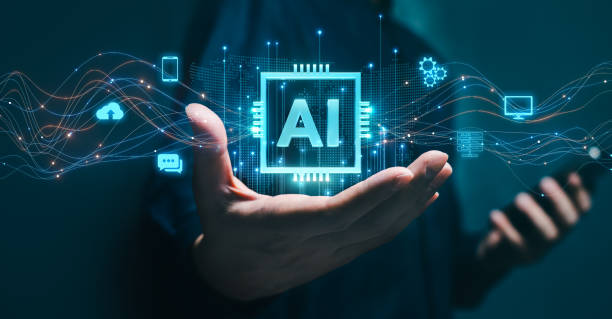What is an AI Robot and How Does it Work?

#Artificial Intelligence Robot (AI Robot) refers to a combination of robotics and artificial intelligence, in which a physical or virtual robot is capable of performing complex tasks and making decisions using artificial intelligence algorithms.
These robots can sense their environment, process information, and act accordingly.
The fundamental operation of an AI robot is based on machine learning, natural language processing, machine vision, and other artificial intelligence techniques.
Machine learning enables the robot to identify patterns by analyzing data and improve its performance.
Natural language processing gives the robot the ability to understand human language and communicate with it.
Machine vision allows the robot to analyze images and videos and identify objects.
AI robots have applications in various fields such as manufacturing, services, healthcare, education, and research.
For example, in the manufacturing industry, AI robots can be used to perform repetitive and dangerous tasks, while in services, they can assist customers as virtual assistants.
Artificial intelligence and artificial intelligence are changing the world.
AI robots collect information from the environment using sensors and cameras.
This information is then processed by artificial intelligence algorithms, and the robot decides what to do based on this processing.
For example, an AI robot that works in a warehouse can identify the location of goods using cameras and sensors and move towards them using routing algorithms to pick them up.
Finally, the AI robot can move goods and place them in the desired location using its arms and hands.
Is your e-commerce site ready to attract maximum customers and increase sales? Rasaweb transforms your online business with modern and efficient e-commerce website designs.
✅ Increased speed and SEO improvement
✅ Excellent user experience on mobile and desktop⚡ Get a free e-commerce website design consultation from Rasaweb!
Diverse Applications of AI Robots

AI robots play a role in various aspects of our lives.
In the healthcare industry, surgical robots can perform surgeries with higher precision than humans.
Also, nursing robots can assist patients with daily tasks and monitor their vital signs.
In the energy industry, inspection robots can examine pipelines and facilities and identify leaks.
This helps prevent accidents and preserve the environment.
In the education sector, teacher robots can help students learn various subjects and answer their questions.
Additionally, AI robots can assist teachers in grading assignments and evaluating student performance.
AI robots also have many applications at home.
Household robots can perform chores, such as vacuuming, washing dishes, and cooking.
Moreover, companion robots can accompany the elderly and disabled and help them with daily tasks.
Robotics is expanding, and AI robots play an important role in this expansion.
Furthermore, AI robots are also used in the defense industry.
Combat robots can fight in battlefields instead of humans and prevent human casualties.
Also, reconnaissance robots can gather information and help security forces identify threats.
These applications show that AI robots have high potential to improve our lives, but at the same time, there are concerns about their effects on employment and security.
Advantages and Disadvantages of Using AI Robots

The use of AI robots has many advantages.
These robots can perform repetitive and dangerous tasks with greater accuracy and speed than humans.
This can lead to increased productivity and reduced costs.
AI robots can help improve our quality of life.
For example, surgical robots can perform surgeries with higher precision, and nursing robots can assist patients with daily tasks.
Additionally, AI robots can help the elderly and disabled with daily tasks, allowing them to live more independently.
However, the use of AI robots also has disadvantages.
One of the most important disadvantages is job displacement.
With the entry of robots into the workforce, many jobs previously performed by humans are now being done by robots.
This can lead to increased unemployment and reduced income.
Another disadvantage is over-reliance on robots.
If we become too dependent on robots, we may face serious problems if they malfunction or fail.
Also, we may lose our skills and be unable to perform tasks we previously did with ease.
Furthermore, there are concerns about the security of AI robots.
If AI robots are hacked or misused, serious risks may arise.
For example, combat robots could be used to kill humans, and surveillance robots could be used to spy on individuals.
Therefore, it is necessary to consider these disadvantages and risks and find solutions for them before widespread use of AI robots.
| Feature | Advantages | Disadvantages |
|---|---|---|
| Accuracy | High accuracy in performing tasks | Errors in case of incomplete data |
| Speed | High speed in information processing | Requires powerful hardware |
| Cost | Reduction in human labor costs | High initial cost |
Challenges Facing AI Robot Development

The development of AI robots faces numerous challenges.
One of the most important challenges is the lack of training data.
For AI robots to learn effectively, they need a large volume of training data.
This data must be diverse, accurate, and complete.
Collecting and preparing this data can be very costly and time-consuming.
Another challenge is the complexity of AI algorithms.
AI algorithms are very complex and require high expertise and knowledge to develop and implement them.
Also, these algorithms must be continuously improved to adapt to environmental changes.
Ethical issues are also a significant challenge in AI robot development.
It must be ensured that AI robots are designed and used in a way that does not violate human rights and values.
For example, discriminatory decisions by AI robots must be prevented, and individuals’ privacy must be protected.
AI robots must act impartially in their decision-making.
Furthermore, it must be ensured that AI robots cannot be used for malicious purposes.
This requires establishing appropriate laws and regulations for the development and use of AI robots.
Another challenge is the public acceptance of AI robots.
Many people are still skeptical about AI robots and are concerned about their effects on their lives.
To increase public acceptance of AI robots, accurate information about them must be provided, and people’s concerns must be addressed.
Also, it must be shown that AI robots can help improve our lives and create new opportunities.
AI robots are powerful tools that can be used for the benefit of humanity.
Did you know your company’s website is the first point of contact for 75% of potential customers?
Your website is the face of your brand. With **Rasaweb**’s corporate website design services, build an online presence that earns customer trust.
✅ Create a professional and lasting brand image
✅ Attract target customers and increase online credibility
⚡ Get a free consultation from **Rasaweb** experts now!
What Will Be the Future of AI Robots?

The future of AI robots looks very bright and promising.
With continuous advancements in artificial intelligence and robotics, AI robots are expected to play a much more significant role in our lives in the near future.
These robots can be applied in various fields such as manufacturing, services, healthcare, education, and research and help improve our quality of life.
AI robots will be able to perform more complex and precise tasks.
It is expected that AI robots in the future will be able to learn and adapt to new environments independently.
This will enable them to operate effectively in different conditions and help solve complex problems.
Also, AI robots are expected to be able to communicate more naturally and effectively with humans in the future.
This will enable them to act as personal assistants and human collaborators.
AI robots, as colleagues and assistants, can help humans.
However, the future development of AI robots requires attention to ethical and social issues.
It must be ensured that AI robots are designed and used in a way that does not violate human rights and values and contributes to creating a fairer and more equal society.
Also, the effects of AI robots on employment and the economy must be considered, and solutions must be found to mitigate their negative impacts.
AI robots must be used for the benefit of humanity and should not become a tool for exploitation and discrimination.
The future of robotics and artificial intelligence depends on human-machine collaboration.
Effects of AI Robots on Employment and Economy

One of the main concerns regarding the development of AI robots is their effects on employment and the economy.
Many experts believe that with the entry of robots into the workforce, many jobs previously performed by humans will be eliminated.
This can lead to increased unemployment and reduced income.
With this in mind, some other experts believe that AI robots can create new job opportunities and contribute to economic growth.
They argue that robots can perform repetitive and dangerous tasks, allowing humans to focus on more creative and valuable tasks.
AI robots can perform repetitive tasks and give humans the opportunity to do creative work.
In general, the effects of AI robots on employment and the economy are complex and multifaceted.
These effects depend on various factors such as the speed of AI robot development, how the benefits from using robots are distributed, and government policies to support workers and businesses.
To mitigate the negative effects of AI robots on employment, governments need to adopt policies that help workers learn new skills and adapt to changes in the labor market.
Also, businesses that use robots need to be supported so they can create new job opportunities.
AI robots require proper management and policy-making.
Furthermore, attention must be paid to the distribution of benefits from using robots.
If the benefits from using robots only reach a few, it may lead to increased economic and social inequality.
Therefore, policies must be adopted to ensure that the benefits from using robots are distributed more equitably.
For example, taxes on income from using robots could be used to support workers and social security.
AI robots should benefit all members of society.
Ethical Issues Related to AI Robots

The development of AI robots brings with it numerous ethical issues.
One of the most important ethical issues is accountability.
If an AI robot makes a mistake and causes damage, who is responsible? Is the robot’s manufacturer responsible, or the robot’s owner, or the robot itself? These questions still have no definitive answers and require further discussion and consideration.
Also, it must be ensured that AI robots are designed and used in a way that does not violate human rights and values.
For example, discriminatory decisions by AI robots must be prevented, and individuals’ privacy must be protected.
AI robots should not violate human rights.
Another ethical issue is the use of AI robots in warfare.
Is it ethical to use combat robots capable of independent decision-making? Can these robots comply with the laws of war and refrain from killing innocent people? These questions also require serious discussion and consideration.
Furthermore, attention must be paid to the effects of AI robots on human relationships.
If we become too dependent on robots, our human relationships may weaken, and we may feel loneliness and isolation.
AI robots should not replace human relationships.
To resolve ethical issues related to AI robots, a comprehensive and inclusive ethical framework needs to be established.
This framework should include principles such as accountability, transparency, justice, respect for privacy, and preservation of human rights.
Also, an independent regulatory body needs to be created to oversee the development and use of AI robots and ensure adherence to ethical principles.
AI robots must be subject to ethical oversight.
| Ethical Issue | Description | Solutions |
|---|---|---|
| Accountability | Who is responsible for robot errors? | Defining legal and ethical responsibility |
| Discrimination | Avoiding discriminatory decisions | Creating fair algorithms |
| Privacy | Protecting individuals’ personal information | Formulating privacy laws |
How AI Robots Learn and Are Trained

AI robots are trained using machine learning algorithms.
Machine learning enables robots to identify patterns by analyzing data and improve their performance.
Various types of machine learning algorithms exist, including supervised learning, unsupervised learning, and reinforcement learning.
In supervised learning, robots are trained using labeled data.
This data includes expected inputs and outputs.
Robots learn how to produce expected outputs based on inputs by analyzing this data.
AI robots learn by analyzing data and identifying patterns.
In unsupervised learning, robots are trained using unlabeled data.
This data includes inputs without expected outputs.
Robots learn to identify hidden patterns and structures in the data by analyzing this data.
In reinforcement learning, robots are trained using environmental feedback.
By performing various actions in the environment and receiving positive or negative feedback, robots learn how to perform actions that lead to receiving the most positive feedback.
AI robots learn by receiving feedback from the environment and improve their performance.
In addition to machine learning algorithms, other techniques are also used to train AI robots, including simulation, transfer learning, and multi-task learning.
In simulation, robots are trained in a simulated environment.
This allows them to learn new skills without the risk of harming themselves or others.
In transfer learning, robots use knowledge and skills learned in one domain to learn in another domain.
In multi-task learning, robots learn multiple tasks simultaneously.
AI robots are trained using various techniques and improve their skills.
Are you tired of losing business opportunities due to not having a professional corporate website?
Rasaweb, with its professional corporate website design, helps you:
✅ Build a powerful and reliable brand image
✅ Convert website visitors into loyal customers
⚡ Get a free consultation now!
The Role of Data in the Development and Performance of AI Robots
![]()
Data plays a very important role in the development and performance of AI robots.
AI robots need a lot of data to learn and improve their performance.
This data must be diverse, accurate, and complete.
The more and higher quality the training data, the better AI robots can perform.
Data enables AI robots to identify patterns, make decisions, and adapt to the environment.
AI robots need a lot of data to learn and improve their performance.
Various types of data are used to train AI robots, including textual data, image data, audio data, and sensor data.
Textual data can include articles, books, websites, and social networks.
Image data can include photos, videos, and satellite images.
Audio data can include sounds, music, and speeches.
Sensor data can include temperature, pressure, humidity, and acceleration data.
AI robots are trained using various types of data and improve their skills.
Collecting and preparing data can be very costly and time-consuming.
However, investing in data is essential for the development of AI robots.
Without sufficient data, AI robots cannot perform well and cannot reach their full potential.
Therefore, it is necessary for organizations and governments to invest more in collecting, preparing, and sharing data.
AI robots cannot perform well without sufficient data.
How to Build an AI Robot?

Building an AI robot is a complex and multi-stage process that requires knowledge and expertise in various fields such as robotics, artificial intelligence, programming, and electronics.
However, by using available tools and resources, a simple AI robot can also be built.
The main steps for building an AI robot are
- Determine the robot’s goal and tasks.
- Select appropriate hardware.
- Select appropriate software.
- Collect training data.
- Train the robot.
- Test and evaluate the robot.
In the first step, you need to define the robot’s goal and tasks.
What is your robot supposed to do? What problems should it solve? By defining the robot’s goal and tasks, you can select the appropriate hardware and software.
In the second step, you need to select the appropriate hardware.
The robot’s hardware includes physical parts such as the body, motors, sensors, cameras, and processor.
The robot’s hardware must be compatible with its goal and tasks.
An AI robot needs appropriate hardware to function correctly.
In the third step, you need to select the appropriate software.
The robot’s software includes the operating system, drivers, libraries, and artificial intelligence algorithms.
The robot’s software must be compatible with the robot’s hardware and allow for its control and programming.
In the fourth step, you need to collect training data.
Training data is used to train the robot.
Training data must be diverse, accurate, and complete.
AI robots are trained using data and improve their skills.
Then we start training the robot and perform robot testing and evaluation.
Frequently Asked Questions
| Row | Question | Answer |
|---|---|---|
| 1 | What is an AI robot? | An AI robot is a machine capable of understanding, reasoning, learning, and problem-solving, and can perform complex tasks with relative autonomy. |
| 2 | What are the most important applications of AI robots? | Main applications include industrial manufacturing, customer services (chatbots), medicine and surgery, autonomous transportation, space exploration, and military affairs. |
| 3 | What is the main difference between an AI robot and a regular robot? | A regular robot only follows programmed instructions, while an AI robot can learn from data, make decisions, and adapt itself to new environments. |
| 4 | How do AI robots learn? | They identify patterns and improve their performance through machine learning algorithms (such as deep learning, reinforcement learning) and processing vast amounts of data. |
| 5 | Can AI robots have emotions? | Currently, AI robots do not possess real emotions in the human sense. They can imitate or recognize emotions, but they do not understand or experience them. |
| 6 | What are the current limitations of AI robots? | Limitations include the need for large amounts of data, inability to understand abstract concepts, lack of true creativity, ethical issues, and generalization challenges in new environments. |
| 7 | What is the role of AI in the development of humanoid robots? | AI helps humanoid robots walk, maintain balance, perceive their surroundings, interact with humans, and perform complex tasks. |
| 8 | How is the future of AI robots predicted? | It is predicted that AI robots will become smarter, more autonomous, and capable of performing more complex tasks in daily life and industry, and their interaction with humans will increase. |
| 9 | Can AI robots replace all human jobs? | It is unlikely that all human jobs will be replaced. Robots will take over many repetitive and dangerous tasks, but jobs requiring creativity, empathy, and ethical judgment will remain. |
| 10 | What ethical and social challenges arise with the expansion of AI robots? | Challenges include issues related to privacy, data security, ethical decision-making by robots, impact on employment, and accountability in case of errors. |
And other services of Rasaweb advertising agency in the field of advertising
- Smart Direct Marketing: A combination of creativity and technology to increase website traffic through key page optimization.
- Smart Sales Automation: An effective tool for online growth with the help of attractive UI design.
- Smart Website Development: Designed for businesses looking to manage campaigns through custom programming.
- Smart Marketplace: A professional solution for managing campaigns with a focus on precise audience targeting.
- Smart Direct Marketing: An effective tool for customer acquisition with the help of Google Ads management.
And hundreds of other services in the field of internet advertising, advertising consulting, and organizational solutions
Internet Advertising | Advertising Strategy | Advertorials
Sources
AI on Zoomit
AI Articles on Digiato
AI News on ITResan
AI Tutorials on Faradars
? To elevate your business in the digital world and achieve peak success, Rasaweb Afarin Digital Marketing Agency is always by your side, offering services such as exclusive website design, SEO, and content marketing.
📍 Tehran, Mirdamad Street, next to Central Bank, Southern Kazeroun Alley, Ramin Alley No. 6
